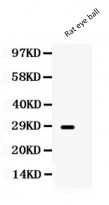ARG59043
anti-MIP / Aquaporin 0 antibody
anti-MIP / Aquaporin 0 antibody for Western blot and Rat
Overview
| Product Description | Rabbit Polyclonal antibody recognizes MIP / Aquaporin 0 |
|---|---|
| Tested Reactivity | Rat |
| Predict Reactivity | Hu |
| Tested Application | WB |
| Host | Rabbit |
| Clonality | Polyclonal |
| Isotype | IgG |
| Target Name | MIP / Aquaporin 0 |
| Antigen Species | Human |
| Immunogen | Synthetic peptide corresponding to aa. 232-263 of Human Aquaporin 0 (ERLSVLKGAKPDVSNGQPEVTGEPVELNTQAL). |
| Conjugation | Un-conjugated |
| Alternate Names | Aquaporin-0; LIM1; AQP0; Lens fiber major intrinsic protein; MIP26; CTRCT15; MP26 |
Application Instructions
| Application Suggestion |
|
||||
|---|---|---|---|---|---|
| Application Note | * The dilutions indicate recommended starting dilutions and the optimal dilutions or concentrations should be determined by the scientist. |
Properties
| Form | Liquid |
|---|---|
| Purification | Affinity purification with immunogen. |
| Buffer | 0.2% Na2HPO4, 0.9% NaCl, 0.05% Sodium azide and 5% BSA. |
| Preservative | 0.05% Sodium azide |
| Stabilizer | 5% BSA |
| Concentration | 0.5 mg/ml |
| Storage Instruction | For continuous use, store undiluted antibody at 2-8°C for up to a week. For long-term storage, aliquot and store at -20°C or below. Storage in frost free freezers is not recommended. Avoid repeated freeze/thaw cycles. Suggest spin the vial prior to opening. The antibody solution should be gently mixed before use. |
| Note | For laboratory research only, not for drug, diagnostic or other use. |
Bioinformation
| Gene Symbol | MIP |
|---|---|
| Gene Full Name | major intrinsic protein of lens fiber |
| Background | Major intrinsic protein is a member of the water-transporting aquaporins as well as the original member of the MIP family of channel proteins. The function of the fiber cell membrane protein encoded by this gene is undetermined, yet this protein is speculated to play a role in intracellular communication. The MIP protein is expressed in the ocular lens and is required for correct lens function. This gene has been mapped among aquaporins AQP2, AQP5, and AQP6, in a potential gene cluster at 12q13. [provided by RefSeq, Jul 2008] |
| Function | Water channel. Channel activity is down-regulated by CALM when cytoplasmic Ca(2+) levels are increased. May be responsible for regulating the osmolarity of the lens. Interactions between homotetramers from adjoining membranes may stabilize cell junctions in the eye lens core (By similarity). [UniProt] |
| Cellular Localization | Cell membrane; Multi- pass membrane protein. Cell junction, gap junction. [UniProt] |
| Calculated MW | 28 kDa |
| PTM | Subject to partial proteolytic cleavage in the eye lens core. Partial proteolysis promotes interactions between tetramers from adjoining membranes (By similarity). Fatty acylated at Met-1 and Lys-238. The acyl modifications, in decreasing order of ion abundance, are: oleoyl (C18:1) > palmitoyl (C16:0) > stearoyl (C18:0) > eicosenoyl (C20:1) > dihomo-gamma-linolenoyl (C20:3) > palmitoleoyl (C16:1) > eicosadienoyl (C20:2). [UniProt] |
Images (1) Click the Picture to Zoom In






